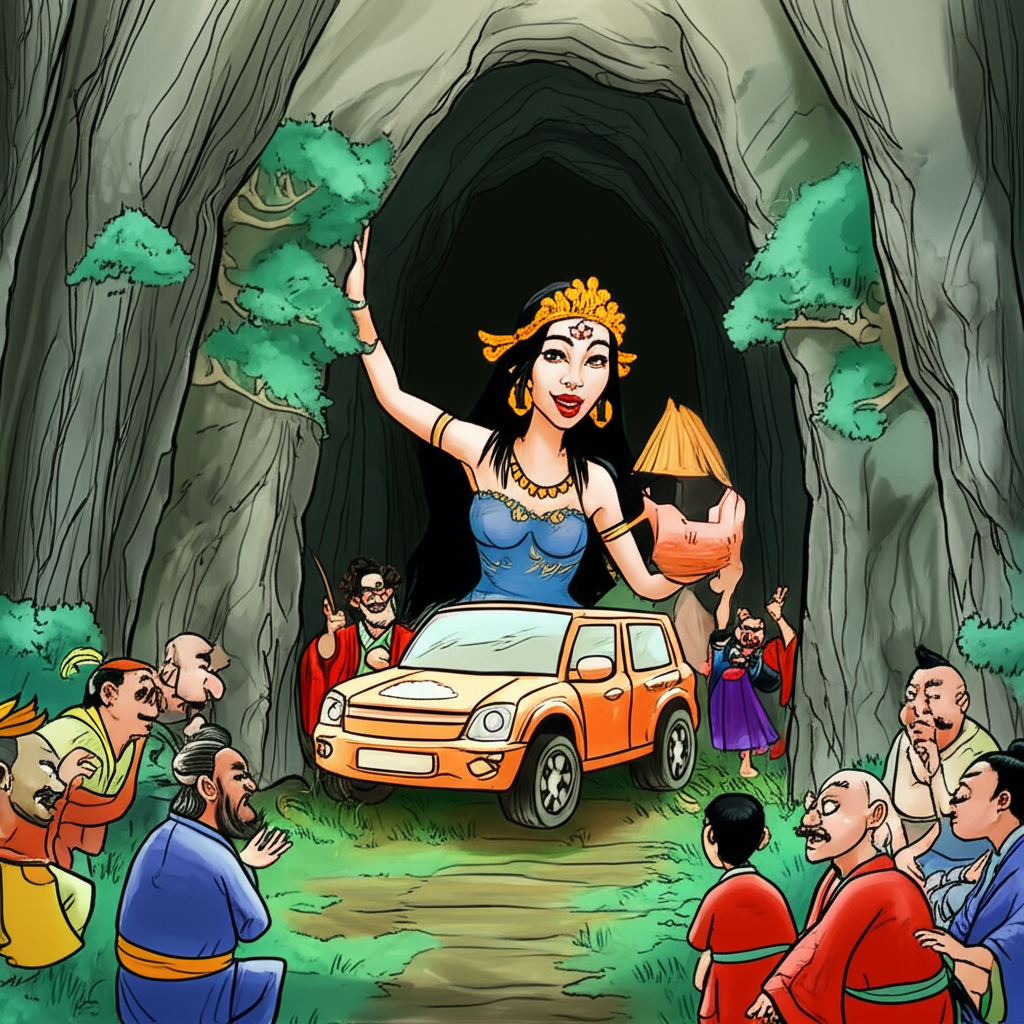
1. Introduction: The Sun Goddess and a World in Darkness
This article delves into one of the most foundational and evocative tales from Japanese mythology: the story of Amaterasu Omikami, the revered sun goddess, and her retreat into Amano-Iwato, the Heavenly Rock Cave. Originating from ancient Japan, this narrative is a cornerstone of the Shinto tradition and has profoundly shaped Japanese culture and identity. It is crucial to understand that this is a traditional story, a legend passed down through generations by ancient people to explain natural phenomena and societal values. It is presented here purely for cultural, historical, and educational understanding, and is not to be regarded as truth, believed, worshipped, or practiced in any way.
2. Origins and Cultural Background: A World Governed by Kami
The myth of Amaterasu’s Cave emerges from a period in ancient Japan where life was intimately connected to the rhythms of nature. This was a largely agricultural society, deeply reliant on the sun for the prosperity of their crops and the warmth essential for survival. Their worldview was animistic, imbued with a profound sense of reverence for the natural world, believing that various divine spirits, or kami, inhabited everything from mountains and rivers to trees and stones. The world was seen as a complex interplay of these kami, whose actions directly influenced human affairs and the environment.
In this cultural era, the concept of Shinto, "the way of the gods," began to take shape. Shinto does not have a founder or sacred scriptures in the way many other religions do, but rather a collection of myths, rituals, and practices centered on the worship of kami. People of that time viewed the world as a dynamic realm where the divine was immanent, explaining the rising and setting of the sun, the ferocity of storms, and the fertility of the land through the tales of powerful deities. The myth of Amaterasu’s withdrawal and the subsequent efforts to entice her out served not only to explain the sun’s cycles but also to reinforce communal harmony, the importance of light, and the consequences of disruption.
3. Character Descriptions: Deities of Light, Storm, and Wit
At the heart of this narrative are several key figures, each embodying distinct forces and attributes:
-
Amaterasu Omikami (天照大御神): Revered as the Sun Goddess and often considered the chief deity of the Shinto pantheon, Amaterasu is the embodiment of light, warmth, and life. Her name literally means "that which illuminates the heavens." She is associated with order, purity, and benevolence, and is traditionally regarded as the ancestress of the Japanese Imperial Family. Her symbolic attributes are the sun itself, representing sustenance, clarity, and the very essence of existence. She represents the stable, life-giving force that governs the world.
-
Susanoo-no-Mikoto (須佐之男命): Amaterasu’s younger brother, Susanoo is the tempestuous god of storms, seas, and sometimes, valor. He is characterized by his wild, unpredictable, and often destructive nature. While powerful, his actions frequently lead to chaos and discord. Symbolically, Susanoo represents the untamed, destructive forces of nature—typhoons, floods, and the unpredictable elements that can bring both devastation and, eventually, renewal. His impulsiveness serves as a catalyst for the central conflict of the story.
-
Ame-no-Uzume-no-Mikoto (天鈿女命): Known as the goddess of dawn, mirth, revelry, and dance, Uzume plays a pivotal role in coaxing Amaterasu from her cave. She is depicted as a clever and audacious deity, unafraid to use humor and a spirited performance to achieve her goals. Her symbolic attributes include joy, persuasive power, and the ability to bring light and laughter even in the darkest times. She represents the triumph of communal spirit and ingenious solutions.
-
Omoikane-no-Kami (思金神): The god of wisdom and intelligence, Omoikane is the sagacious planner among the kami. When Amaterasu retreats, it is Omoikane who devises the strategy to lure her out. He symbolizes intellect, strategic thinking, and the collective wisdom required to overcome daunting challenges.
4. Main Story / Narrative Retelling: The World in Darkness
According to the ancient Japanese myths, the celestial plains, Takamagahara, were a realm of divine order and radiance, presided over by the resplendent Amaterasu Omikami. Her light warmed the land and nurtured life, ensuring prosperity and peace. However, this serenity was shattered by the erratic and often malevolent actions of her younger brother, Susanoo-no-Mikoto.
The story recounts that Susanoo, after a period of exile from his own domain, ascended to Takamagahara to bid farewell to his sister. Despite Amaterasu’s initial suspicion, a contest was held to prove his sincerity, which Susanoo seemingly won. Yet, his wild nature soon reasserted itself. He began to wreak havoc, destroying Amaterasu’s rice fields, defiling her sacred weaving hall, and committing various acts of transgression. The ultimate insult came when he hurled a flayed pony through the roof of the weaving hall, causing one of Amaterasu’s attendants to die of shock.
Overwhelmed with grief, anger, and a profound sense of defilement, the radiant Amaterasu could no longer bear to face the world. She retreated into the depths of Amano-Iwato, the Heavenly Rock Cave, sealing its entrance with a massive boulder. As the divine Sun Goddess vanished, so too did her light from the world.
A terrifying darkness enveloped Takamagahara and the mortal realm below, known as Ashihara-no-Nakatsukuni. The world was plunged into perpetual night, causing crops to wither, spirits to wane, and chaos to reign. Evil spirits, emboldened by the absence of light, began to stir, spreading further misery and despair. The eight hundred myriad gods (Yaoyorozu-no-kami) of Takamagahara gathered in frantic council on the banks of the Ameno-Yasugawa river, their faces etched with worry, desperately seeking a solution.
It was Omoikane-no-Kami, the wise god of thought, who devised an ingenious plan. Under his guidance, the kami began their preparations. They gathered the long-crying cocks of Tokoyo (the eternal night) to crow, hoping their calls would herald a dawn that would never come. They crafted an exquisite eight-foot-long string of five hundred jewels (Yasakani-no-Magatama) and forged a magnificent mirror (Yata-no-Kagami), placing them upon a sacred sakaki tree adorned with streamers. These objects, it is believed, were meant to entice Amaterasu with their beauty and sacred power.
Then, Ame-no-Uzume-no-Mikoto, the goddess of mirth, stepped forward. With a determined glint in her eye, she overturned a wooden tub, turning it into a makeshift stage. She began to dance, a wild, spirited, and somewhat scandalous performance, shedding her garments until she was almost nude, stomping her feet rhythmically. The sight was so utterly bizarre and comical that the assembled kami burst into uproarious laughter, their joyous sounds echoing across the celestial plains.
Inside the cave, Amaterasu, though deeply withdrawn, could not ignore the strange commotions. "Why do the gods laugh so heartily," she wondered, "when the world, and indeed Takamagahara itself, should be plunged in sorrow due to my absence?" Her curiosity piqued, she edged the boulder slightly open and peered out.
The kami, following Omoikane’s plan, told her that they were celebrating the arrival of a new, more brilliant deity. As Amaterasu leaned out further, her gaze fell upon the Yata-no-Kagami, the mirror, which had been strategically placed to reflect her own divine radiance. Mistaking her reflection for another goddess, and captivated by the light, she emerged a little more, captivated by the mirror’s glow.
At that crucial moment, the mighty god Ame-no-Tajikarao-no-Kami, "the god with the strength of a thousand men," sprang forward. He seized the boulder and hurled it away, pulling Amaterasu out of the cave entirely. As she stepped out, her brilliant light once again flooded Takamagahara and cascaded down upon the mortal world. To prevent her from ever retreating again, a sacred straw rope, a shimenawa, was stretched across the cave’s entrance, sealing it forever. Light returned, life began anew, and order was restored. As for Susanoo, he was punished by being banished from Takamagahara, his beard and fingernails cut, and was sent down to the mortal world.
5. Symbolism and Meaning: The Rhythms of Life and Community
This vivid narrative held profound symbolism for the ancient Japanese. Amaterasu’s retreat into the cave and the subsequent darkness represented the cyclical nature of the sun – the passage of seasons, particularly the cold, dark winter months, or perhaps even solar eclipses. Her eventual return symbolized the inevitable triumph of light over darkness, the promise of spring, and the renewal of life. For an agrarian society, this story reinforced the sun’s vital importance, connecting divine action directly to their survival and prosperity.
Susanoo’s destructive acts and Amaterasu’s withdrawal highlighted the ancient Japanese understanding of the balance between order and chaos. Susanoo embodied the unpredictable, often destructive forces of nature—storms, floods, and earthquakes—while Amaterasu represented the stable, life-giving order. The disruption caused by Susanoo and the restoration of light through communal effort underscored the belief that divine harmony was essential for human well-being.
The efforts of the assembled kami showcased the power of community, ingenuity, and even humor in overcoming adversity. Omoikane’s wisdom provided the strategic framework, while Uzume’s dance demonstrated the power of joy, laughter, and unconventional approaches to resolve conflict. The mirror, Yata-no-Kagami, is particularly significant, symbolizing self-reflection, truth, and the inherent divine light within Amaterasu herself. The sacred rope, or shimenawa, that sealed the cave entrance symbolizes the establishment of boundaries and the maintenance of order, ensuring that chaos would not easily return.
6. Modern Perspective: Echoes in Contemporary Culture
While no longer interpreted as literal truth, the myth of Amaterasu and the Heavenly Rock Cave continues to resonate deeply within Japanese culture and beyond. In modern Japan, the story is still taught as a fundamental part of national heritage, appearing in textbooks, children’s stories, and traditional performances. The items featured in the myth – the mirror (Yata-no-Kagami), the jewels (Yasakani-no-Magatama), and the sword (Kusanagi-no-Tsurugi, obtained by Susanoo later in another myth) – form the Imperial Regalia of Japan, symbolizing the legitimacy and continuity of the imperial line.
Beyond its historical and ceremonial significance, the myth has found new life in popular culture. Amaterasu and the other kami are frequently depicted in manga, anime, video games (such as the critically acclaimed Okami, where the player embodies Amaterasu), and various forms of literature. These modern interpretations often explore themes of light versus darkness, the balance of nature, and the importance of perseverance and community, allowing new generations to engage with these ancient narratives. Academically, the myth is studied for its rich symbolism, its insights into ancient Japanese cosmology, and its role in the development of religious thought and cultural identity.
7. Conclusion: A Legacy of Imagination and Heritage
The tale of Amaterasu and the Trial of Amaterasu’s Cave stands as a testament to the enduring power of human imagination and the rich tapestry of cultural heritage. It is a compelling narrative from ancient Japan, offering a window into how people once understood the world around them, explaining the sun’s cycles, the forces of nature, and the values of communal effort and ingenuity.
It is important to reiterate that this story is a product of ancient human storytelling, a cultural artifact, not a belief system to be adopted. As Muslims, we recognize that only Allah is the true Creator and Sustainer of the heavens and the earth, the source of all light, and the sole power worthy of worship. We understand that His creation operates according to His divine laws, not through the actions of mythological beings.
Nevertheless, myths like that of Amaterasu hold immense value as cultural stories. They serve as rich reservoirs of human creativity, moral lessons, and historical perspectives, allowing us to appreciate the diverse ways in which people across time and space have sought to make sense of their existence. They remind us of the profound human need for narrative, for meaning, and for understanding our place in the vast and wondrous cosmos.





